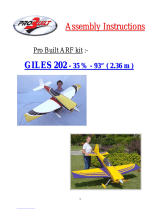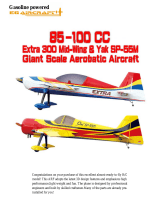ple of small drops of thin CA. Remove the servos carefully, and glue the mounts to the hatch cov-
ers permanently with thin CA, and then reinforce the glue joints between the servo mount and
the hatch with slow (at least 30 minute) epoxy and milled fibre, with a nice glue fillet all around.
Re-install the servos. If using SWB 1” arms you will need to redrill the outer hole Ø 3.0mm for
the pins of the M3 aluminum clevises. Route the servo lead, and extension cable as needed, for-
ward thru’ the holes in the wing spar to the opening in the front of the ply root rib. Don’t forget to
tape any slack cable to the inside of the wing skin so that it cannot foul the servo linkages.
Finally secure the completed aileron servo hatches to the underside of the wing using 4 of the
sheet-metal screws provided, Ø 2.9 x 10mm. Make up the aileron linkage from the supplied hard-
ware, using the M3 aluminum clevise and an M3 nut at the servo end of the all-threaded rod, and
an M3 ball-link sandwiched between the dual phenolic control horns - retained with an M3 x
16mm bolt and locknut. (see photo above)
Flap servo mounting
The flap servo mounting and linkage is a little unusual, because the axis of the clevises are at
90 degrees to each other, but this works perfectly due to the small travels, and has been fully
tested with many flights of both prototypes.
Assemble the flap servo mounts from the 3 CNC milled plywood parts supplied for each servo,
using thin CA, as shown in the photos right and P6. Then reinforce all the joints with a bead of
30 minute epoxy.
Install the servo with the output shaft nearest the front
of the wing, using the Ø 2.9 x 13mm screws. Of
course, because the servos are mounted inverted in
the mounts you should insert the brass eyelets in the
rubber grommets form the opposite side from usual.
Centre the servos using your R/C and screw the plas-
tic heavy-duty servo arm into place at 90 degrees to
the servo case side. Set the flap servo travel/ATV to
110% in your transmitter (JR).
Make up the 2 linkages from the M3 threaded rods,
with a steel clevise and M3 nut at each end. Make the
length of both linkages (clevise pin to clevise pin)
exactly the same, to ensure identical flap throws, any-
where between 127 - 130mm (5 - 5.1”) is fine. Loctite
the clevise and nut on only the servo ends of both
linkages now. Fit the linkage to the 2nd hole out from
the centre of the servo, so that the side of the steel
clevise with the pin will be only about 0.5 - 1mm away
from the top skin of the wing. This ensures that the
clevise cannot come off the servo arm accidentally.
Install the completed servo mount and linkage into
the wing, so that the servo mount is flat against the
plywood rib, and inserting the linkage thru’ the pre-cut
hole in the trailing edge of the wing. (see photo above
and P5). You can enlarge this hole a little if needed,
and note that it needs to be right against the top sur-
face of the wing skin. Connect the clevise to the phe-
16
(above) Flap servo mounts are assem-
bled from the milled plywood parts sup-
plied, glued together with thin CA and
then reinforced with 30 minute epoxy.
(below) Flap servo mount installed in the
wing, and secured to the plywood rib
with sheetmetal screws. The plastic servo
arm & clevise must be very close to the
top skin of the wing, as shown here.
























